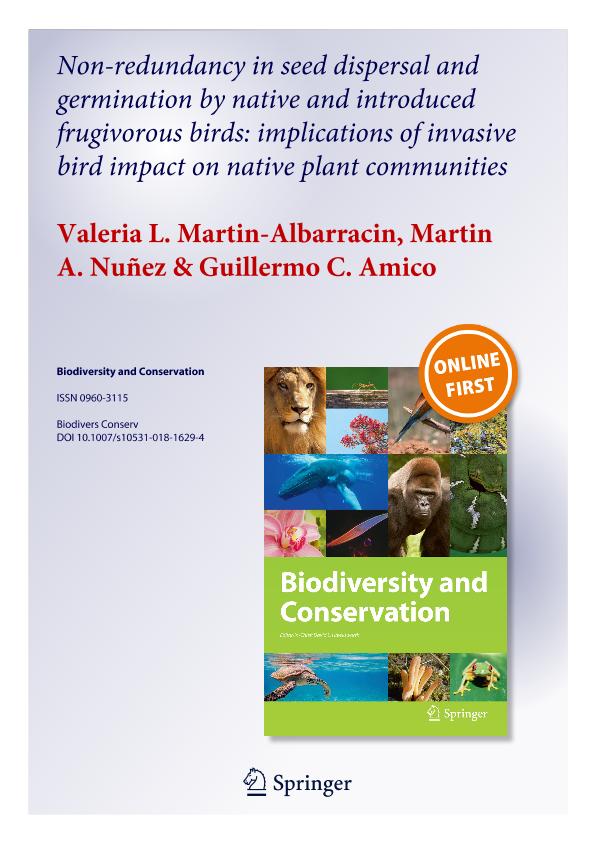Mostrar el registro sencillo del ítem
dc.contributor.author
Martin Albarracin, Valeria Leticia

dc.contributor.author
Nuñez, Martin Andres

dc.contributor.author
Amico, Guillermo Cesar

dc.date.available
2020-01-02T22:15:50Z
dc.date.issued
2018-12
dc.identifier.citation
Martin Albarracin, Valeria Leticia; Nuñez, Martin Andres; Amico, Guillermo Cesar; Non-redundancy in seed dispersal and germination by native and introduced frugivorous birds: implications of invasive bird impact on native plant communities; Springer; Biodiversity and Conservation; 27; 14; 12-2018; 3793-3806
dc.identifier.issn
0960-3115
dc.identifier.uri
http://hdl.handle.net/11336/93333
dc.description.abstract
Seed dispersal by vertebrate animals is important for the establishment of many fleshy-fruited plant species. Different frugivorous species can provide different seed dispersal services according to their specific dietary preferences as well as behaviour and body traits (e.g. body size and beak size of birds). Our aim was to study redundancies and complementarities in seed dispersal and germination between the two main native seed disperser birds and the introduced silver pheasant Lophura nycthemera in the temperate Patagonian forests. For this, we collected fresh droppings from the studied species and analyzed seed content. We conducted germination trials for four plant species common in bird droppings; two native species (Aristotelia chilensis and Rhaphithamnus spinosus) and two invasive non-native species (Rubus ulmifolius and Rosa rubiginosa). Both native frugivorous birds and the silver pheasant dispersed fruits of non- native fleshy-fruited plants, but their roles were non-redundant in terms of species dispersed and effect on seed germination. The silver pheasant dispersed a proportionally high number of non-native seeds, while native birds dispersed a high number of native seeds. In addition, the effect of gut treatment in seed germination differed between seed dispersers. Native birds promoted the germination for the two native plant species studied, while the silver pheasant promoted the germination of one non-native plant. This suggests that seed dispersal by the silver pheasant may contribute to the spread of some invasive fleshy-fruited plants in the ecosystems that otherwise would not be dispersed by any other bird. The understanding of redundancies and complementarities on seed dispersal and germination between native and introduced birds will allow improving the management of fleshy-fruited non-native plants.
dc.format
application/pdf
dc.language.iso
eng
dc.publisher
Springer

dc.rights
info:eu-repo/semantics/openAccess
dc.rights.uri
https://creativecommons.org/licenses/by-nc-sa/2.5/ar/
dc.subject
ENDOZOOCHORY
dc.subject
FLESHY FRUITS
dc.subject
INTRODUCED BIRDS
dc.subject
NON-NATIVE PLANTS
dc.subject
SEED DISPERSAL EFFECTIVENESS
dc.subject
SEED GERMINATION
dc.subject.classification
Ecología

dc.subject.classification
Ciencias Biológicas

dc.subject.classification
CIENCIAS NATURALES Y EXACTAS

dc.title
Non-redundancy in seed dispersal and germination by native and introduced frugivorous birds: implications of invasive bird impact on native plant communities
dc.type
info:eu-repo/semantics/article
dc.type
info:ar-repo/semantics/artículo
dc.type
info:eu-repo/semantics/publishedVersion
dc.date.updated
2019-10-10T13:57:55Z
dc.journal.volume
27
dc.journal.number
14
dc.journal.pagination
3793-3806
dc.journal.pais
Alemania

dc.journal.ciudad
Berlín
dc.description.fil
Fil: Martin Albarracin, Valeria Leticia. Universidad Nacional del Comahue. Centro Regional Universitario Bariloche. Laboratorio de Ecotono; Argentina. Consejo Nacional de Investigaciones Científicas y Técnicas. Centro Científico Tecnológico Conicet - Patagonia Norte. Instituto de Investigaciones en Biodiversidad y Medioambiente. Universidad Nacional del Comahue. Centro Regional Universidad Bariloche. Instituto de Investigaciones en Biodiversidad y Medioambiente; Argentina
dc.description.fil
Fil: Nuñez, Martin Andres. Consejo Nacional de Investigaciones Científicas y Técnicas. Centro Científico Tecnológico Conicet - Patagonia Norte. Instituto de Investigaciones en Biodiversidad y Medioambiente. Universidad Nacional del Comahue. Centro Regional Universidad Bariloche. Instituto de Investigaciones en Biodiversidad y Medioambiente; Argentina
dc.description.fil
Fil: Amico, Guillermo Cesar. Consejo Nacional de Investigaciones Científicas y Técnicas. Centro Científico Tecnológico Conicet - Patagonia Norte. Instituto de Investigaciones en Biodiversidad y Medioambiente. Universidad Nacional del Comahue. Centro Regional Universidad Bariloche. Instituto de Investigaciones en Biodiversidad y Medioambiente; Argentina. Universidad Nacional del Comahue. Centro Regional Universitario Bariloche. Laboratorio de Ecotono; Argentina
dc.journal.title
Biodiversity and Conservation

dc.relation.alternativeid
info:eu-repo/semantics/altIdentifier/url/https://link.springer.com/article/10.1007/s10531-018-1629-4
dc.relation.alternativeid
info:eu-repo/semantics/altIdentifier/doi/http://dx.doi.org/10.1007/s10531-018-1629-4
Archivos asociados
